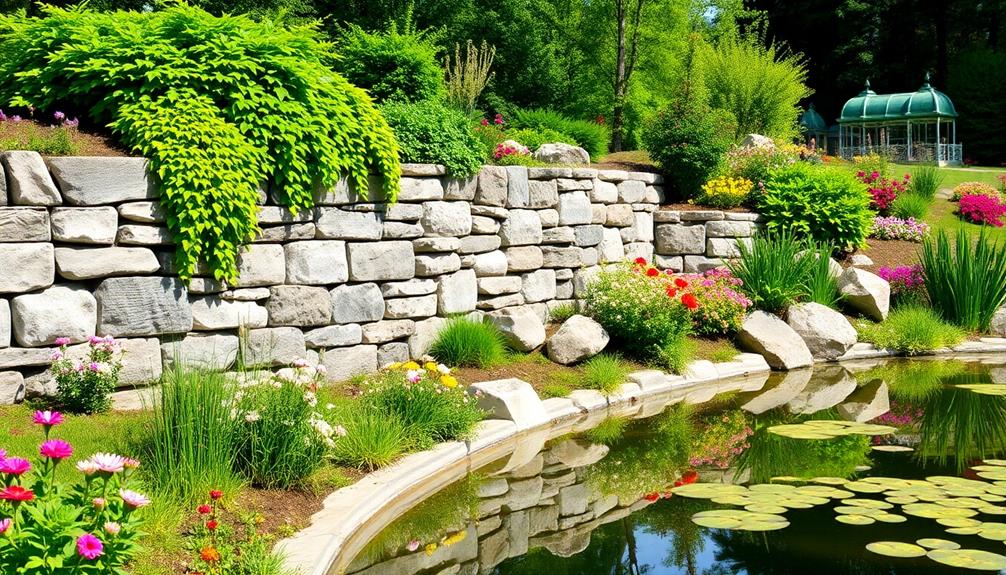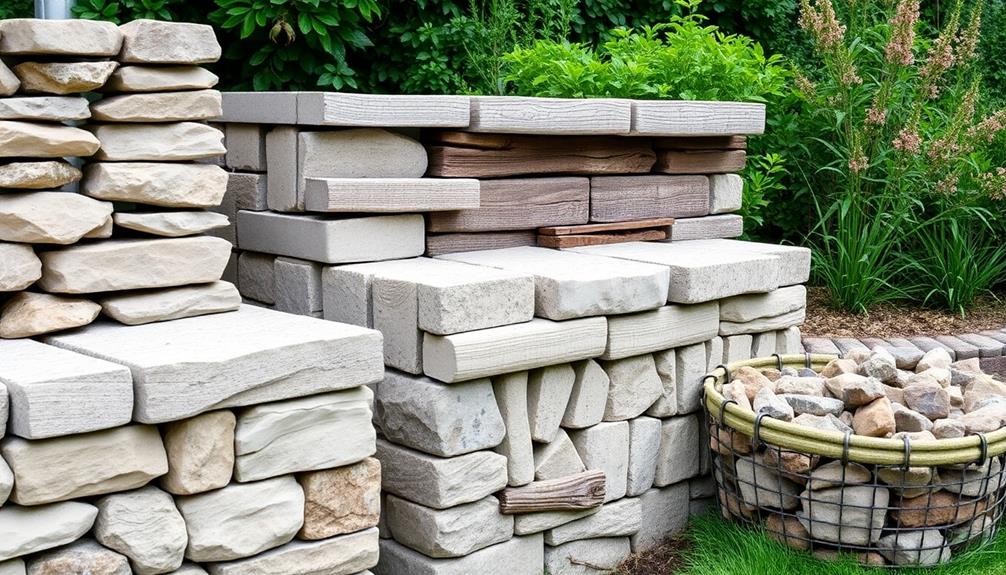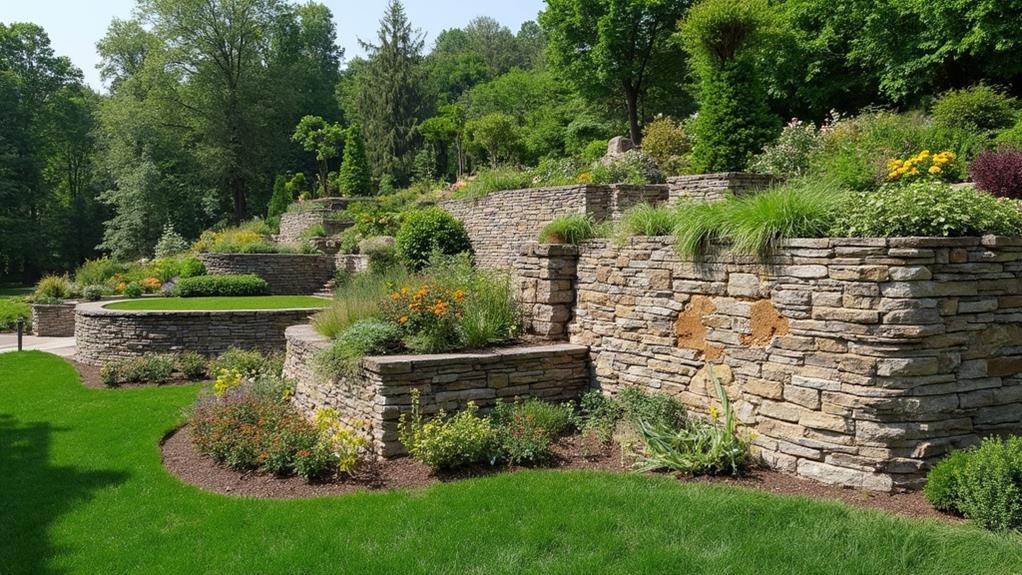Retaining walls, indispensable for soil retention and slope management, are prone to various issues such as subsidence, bulging, and cracking, often due to inadequate soil compaction, poor drainage, or improper construction materials. To address these, appropriate soil compaction and effective drainage systems are essential, along with selecting durable materials such as concrete and stone. Water management challenges, including water buildup due to drainage failures, can be alleviated through proper design and maintenance. Vegetation overgrowth should be controlled through regular maintenance, preventing root intrusion. Understanding these aspects can greatly improve the performance and lifespan of retaining walls. Discover more through further insights.
Table of Contents
ToggleWalls Contractor Highlights
- Ensure proper soil compaction and drainage to prevent subsidence and bulging of retaining walls.
- Use high-quality materials and reinforcement to avoid cracking and deterioration.
- Account for lateral earth pressure and seismic activity to prevent wall tipping and leaning.
- Implement effective drainage systems to manage water buildup and hydrostatic pressure.
- Select durable materials and perform regular maintenance to counter aesthetic degradation and environmental stress.
Definition of Retaining Walls

Retaining walls serve a critical purpose in landscape and structural design by preventing soil erosion and managing water flow, thereby ensuring the stability of the terrain. Constructed from a variety of materials such as concrete, stone, timber, and brick, these walls are engineered to withstand lateral pressure from the retained earth.
Companies like the Granite Company, with over 20 years of expertise, use materials including limestone, boulders, and granite, ensuring both aesthetic and functional durability. Their design and construction are heavily influenced by the specific needs of the site.
The types and styles of retaining walls, ranging from gravity walls to cantilevered structures, offer versatile solutions that can be tailored to both aesthetic and functional requirements.
Purpose and Functionality
A retaining wall serves as a crucial structural element designed to resist the lateral pressure of soil or other materials. These walls are fundamental in landscape architecture, civil engineering, and construction, where they provide necessary support for vertical or near-vertical grade changes.
By counteracting gravity's force on sloped terrains, retaining walls prevent soil erosion and manage water runoff, fostering stability in areas where it might otherwise be compromised. The purpose of a retaining wall extends beyond mere functionality; it can also enhance the aesthetics of a landscape, creating terraces for gardens or pathways, thereby enriching the environment and offering a sense of belonging to nature's embrace.
Functionality-wise, retaining walls are adept at handling varied loads and pressures, making them indispensable in urban planning and infrastructure development. They are engineered to provide safety and durability, accommodating the natural movement of slopes while maintaining structural integrity.
Additionally, these walls can be tailored to specific site conditions, addressing unique challenges posed by soil composition, water tables, and environmental factors. In essence, retaining walls integrate technical proficiency with environmental harmony, ensuring that landscapes remain both beautiful and secure, fostering a sense of community connection and stewardship over the natural world.
Materials and Construction
Constructing retaining walls involves a meticulous selection of materials and techniques that profoundly influence their performance and longevity. The choice of materials is foundational, with options such as concrete, stone, brick, timber, and gabion providing diverse solutions for various needs and aesthetics. Concrete, known for its durability and flexibility, is often favored in modern construction. It can be precast or poured in place, offering robust support for soil retention.
Meanwhile, stone exudes an enduring natural beauty and strength, ideal for landscapes seeking a traditional appeal.
In the construction of retaining walls, the techniques employed are as critical as the materials chosen. Proper site preparation is essential, involving the excavation and leveling of the foundation to guarantee stability. Drainage considerations are paramount to prevent hydrostatic pressure, which can compromise the wall's integrity. Incorporating drainage pipes and gravel backfill mitigates water accumulation, thereby enhancing the wall's durability. Reinforcement, through techniques like geogrid or steel reinforcement, is often necessary for taller or load-bearing walls.
Ultimately, the materials and construction techniques selected reflect not only functional requirements but also an aesthetic vision, ensuring that the retaining wall integrates seamlessly into its environment while serving its intended purpose effectively.
Types and Styles
Numerous types and styles of retaining walls are designed to suit different functional and aesthetic needs, providing both structural support and visual appeal to landscapes. Retaining walls are essential in managing soil and preventing erosion, particularly in areas with varying elevations. Understanding the different styles available can help you select the right wall that fits seamlessly into your landscape design and meets your specific requirements.
Gravity Walls: These walls rely on their sheer weight to hold back soil. They are typically constructed from heavy materials like stone or concrete, making them ideal for supporting substantial loads.
Cantilevered Walls: Using less material than gravity walls, cantilevered walls leverage their unique T-shaped structure to provide support. They are often reinforced with steel to enhance their strength and stability.
Sheet Piling Walls: These are thin walls made of steel, vinyl, or wood, driven directly into the ground. They are most effective when space is limited and soil conditions are favorable.
Anchored Walls: For additional support, anchored walls employ cables or other stays anchored deep into the ground or attached to rock formations, offering enhanced stability for various wall types.
Benefits

Retaining walls offer a multitude of benefits that extend beyond their primary function of erosion control, as they also greatly contribute to enhancing the visual appeal of a property, thereby increasing its overall aesthetic value. These structures not only prevent soil displacement but also improve land usability by transforming uneven terrains into functional spaces, which can be utilized for various purposes such as gardening or outdoor activities.
Furthermore, retaining walls play an essential role in bolstering the structural stability of the landscape, guaranteeing the long-term durability and safety of the property. This type of construction can involve collaboration with experts, including landscape architects and structural engineers, to ensure a perfect blend of design and functionality.
Erosion Control Advantages
When it comes to maintaining the structural integrity of landscapes, effective erosion control is essential, offering a multitude of advantages. Retaining walls serve as a vital component in erosion prevention, stabilizing soil and providing long-term protection against the detrimental effects of water and wind erosion. By incorporating retaining walls, property owners and landscape architects can guarantee the continued stability and usability of outdoor spaces, fostering a sense of belonging and security.
Soil Stabilization: Retaining walls effectively hold back soil, preventing landslides and soil displacement, which is especially beneficial in hilly or uneven terrains.
Water Runoff Management: They redirect water flow, minimizing surface runoff and reducing erosion caused by heavy rainfall, thereby protecting both natural and built environments.
Environmental Protection: By controlling erosion, retaining walls help preserve local ecosystems, protecting plant and animal habitats from being disrupted or destroyed by soil displacement.
Increased Land Usability: With soil erosion mitigated, retaining walls create more usable land, allowing for gardening, pathways, and other landscaping projects, enhancing the functionality and enjoyment of outdoor spaces.
Through these advantages, retaining walls not only fortify landscapes but also contribute to a harmonious and sustainable outdoor environment.
Enhanced Property Aesthetics
Beyond their functional advantages, retaining walls greatly enhance property aesthetics, merging structural utility with visual appeal. By integrating natural materials like stone, brick, or timber, these structures can transform ordinary landscapes into extraordinary environments, providing a harmonious blend between nature and architecture. The thoughtful design of retaining walls can create visually striking terraces, introduce dynamic textures, and offer a sense of depth and dimension to any property.
Incorporating retaining walls into landscape design encourages a sense of community and belonging, as they can delineate spaces for gardens, patios, or communal areas while maintaining a cohesive aesthetic. These walls offer an opportunity to express personal style and contribute to the overall character of a neighborhood, fostering a connection between homeowners and their environment. The meticulous craftsmanship involved in constructing a retaining wall can be an embodiment of quality and permanence, enhancing the property's appeal to both residents and visitors alike.
Improved Land Usability
Enhancing the usability of land is one of the primary benefits of installing retaining walls. These structures play a pivotal role in transforming unusable terrains into functional spaces, allowing property owners to maximize their land's potential. Retaining walls create level areas on sloped terrains, which can be used for various purposes, thus fostering a sense of community and belonging among residents who can fully utilize their surroundings.
Increased Gardening Space: By terracing a slope, retaining walls provide flat surfaces that are ideal for gardens, allowing for a more diverse range of plant species and enhanced aesthetic appeal.
Enhanced Recreational Areas: Level surfaces created by retaining walls can be transformed into patios, playgrounds, or other recreational spaces, promoting social interaction and family activities.
Improved Accessibility: Retaining walls can assist in creating easier pathways and walkways on steep properties, making areas more accessible for all, including those with mobility challenges.
Expanded Building Opportunities: By stabilizing steep slopes, retaining walls create additional buildable areas, offering property owners the opportunity to expand living spaces, adding new structures like sheds or additional rooms.
Through these enhancements, retaining walls provide tangible benefits, elevating both the functionality and the enjoyment of one's property.
Increased Structural Stability
Retaining walls importantly contribute to the structural stability of a property, particularly in areas with uneven or sloped terrains. By providing essential support, these structures prevent soil erosion, landslides, and even foundation damage, thereby safeguarding the integrity of a property. The importance of retaining walls becomes evident in regions prone to heavy rainfall or seismic activity, where soil displacement can pose significant risks.
By anchoring the soil in place, retaining walls enhance the safety and longevity of both residential and commercial landscapes.
The design and construction of retaining walls require meticulous planning and precise engineering to ensure they fulfill their purpose effectively. When constructed with quality materials and proper drainage systems, retaining walls can withstand substantial pressure, distributing loads evenly across their surface. This distribution is pivotal in maintaining the equilibrium of the land, thereby preventing any unforeseen shifts that could compromise structural integrity.
For communities or individuals residing in topographically challenging areas, investing in well-engineered retaining walls fosters a sense of security and belonging. It assures residents that their properties are not only aesthetically pleasing but also resilient against natural adversities. Ultimately, retaining walls are a hallmark of proactive measures in landscape management, offering peace of mind through enhanced stability.
Common Materials Used

In the domain of constructing retaining walls, the choice of material profoundly influences both the functionality and durability of the structure, with popular options including concrete, timber, and natural stone. Each of these materials presents a unique set of advantages and disadvantages, ranging from cost-effectiveness to aesthetic appeal, which must be carefully weighed against their respective longevity and maintenance requirements. The table below provides a concise comparison of these common materials, highlighting key considerations for decision-makers.
| Material | Pros | Cons |
|---|---|---|
| Concrete | Durable, low maintenance | High initial cost |
| Timber | Cost-effective, natural look | Susceptible to rot and pests |
| Natural Stone | Aesthetic appeal, longevity | Expensive, complex installation |
Popular Retaining Wall Materials
Choosing the right materials is essential for constructing a durable and effective retaining wall. The choice of material greatly influences the wall's structural integrity, aesthetic appeal, and longevity, ensuring it not only serves its purpose but also complements the surrounding environment.
Concrete Blocks: Known for their strength and versatility, concrete blocks are a staple in modern retaining wall design. Their interlocking nature provides excellent stability, and they can be customized in various textures and colors to suit different landscapes.
Natural Stone: Valued for its timeless beauty and natural appearance, natural stone is often the material of choice for those seeking an organic look. It offers durability and a sense of permanence, seamlessly integrating with natural surroundings.
Brick: Traditional and classic, brick retaining walls exude an enduring charm. They are ideal for creating a cohesive look, especially when used in conjunction with brick facades or pathways.
Timber: Offering a rustic appeal, timber is favored for its affordability and ease of installation. While not as durable as stone or concrete, treated timber can still provide a practical solution for smaller projects.
Pros and Cons Comparison
Understanding the advantages and disadvantages of different retaining wall materials is fundamental for making an informed decision. Concrete blocks, for example, are popular due to their strength and versatility, allowing for intricate designs and a modern aesthetic. However, they can be costly and may require professional installation to guarantee structural integrity.
Natural stone, prized for its timeless beauty and ability to blend seamlessly into landscapes, offers a unique visual appeal. Yet, its irregular shapes can make construction labor-intensive and time-consuming, often resulting in higher costs.
Timber, another common choice, provides a warm, rustic charm that appeals to those seeking a natural look. It is generally more affordable and easier to install than stone or concrete, making it an attractive option for DIY enthusiasts. Nonetheless, timber is susceptible to rot and insect damage, potentially reducing its longevity.
Brick, known for its durability and classic appearance, offers a middle ground between stone and timber. It is relatively easy to maintain and has a long lifespan, but the initial installation requires precision and skilled craftsmanship to prevent future problems.
Ultimately, the choice of material should align with aesthetic preferences, budget constraints, and the specific requirements of the landscape.
Durability and Maintenance Needs
Durability stands as a cornerstone in evaluating the suitability of retaining wall materials, as it directly impacts long-term performance and maintenance requirements. Selecting the right material involves understanding the inherent properties of each option, particularly how they withstand environmental stresses over time.
Retaining walls, indispensable in landscape architecture, face constant exposure to elements, necessitating materials that offer resilience and minimal upkeep. Common materials used include:
- Concrete: Known for its strength and longevity, concrete is a popular choice due to its ability to withstand significant loads and resistance to weathering. However, it requires periodic inspections to prevent cracking and deterioration, ensuring structural integrity.
- Stone: Chosen for its natural aesthetic and high durability, stone walls require minimal maintenance. They are less prone to degradation, making them an excellent choice for those seeking both form and function.
- Wood: While offering a warm, natural look, wood demands regular maintenance such as sealing and treating to prevent rot and insect damage, which can compromise its lifespan.
- Brick: Offering a classic appearance, brick walls are durable yet necessitate occasional repointing of mortar joints to maintain stability and appearance.
Selecting the right material aligns with the community's values of aesthetics, longevity, and responsible maintenance practices.
Walls Contractor FAQ
How Can Drainage Issues Affect the Stability of a Retaining Wall?
Drainage issues greatly impact retaining wall stability by increasing hydrostatic pressure, which can lead to wall failure. Proper drainage systems are essential to prevent water accumulation, ensuring the wall remains structurally sound and long-lasting, promoting community safety and cohesion.
What Are Signs That a Retaining Wall Is Failing?
Signs of a failing retaining wall include visible cracks, bulging or leaning, water seepage, or soil erosion. Prompt attention to these indicators fosters community safety and secures the structural integrity of shared spaces, enhancing collective well-being.
How Often Should a Retaining Wall Be Inspected for Maintenance?
Retaining walls should be inspected biannually to guarantee structural integrity and prevent potential failures. Regular maintenance fosters community safety and cohesion by addressing issues early, thereby preserving shared spaces and protecting investments in communal and private properties.
Can Tree Roots Impact the Integrity of a Retaining Wall?
Tree roots can substantially affect a retaining wall's integrity by exerting pressure, causing displacement or structural damage. Regular inspections and strategic root management foster a sense of shared responsibility, ensuring the wall's stability and community protection.
What Are Cost-Effective Solutions for Repairing a Damaged Retaining Wall?
Cost-effective solutions for repairing a damaged retaining wall include reinforcing with geogrid materials, utilizing drainage improvements to prevent further damage, and employing skilled labor for precise repairs. These measures guarantee stability, fostering a sense of community security and shared responsibility.







